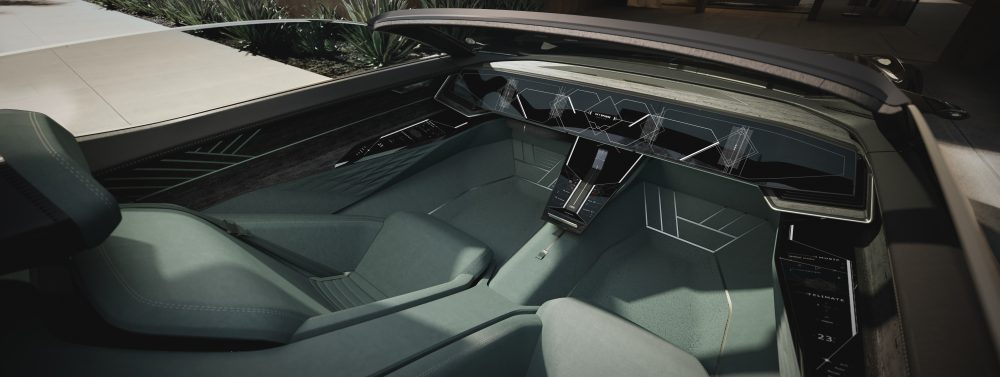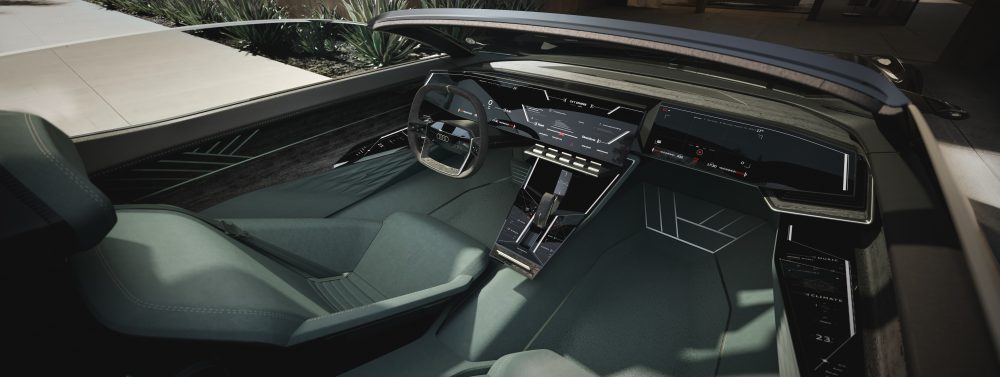
Audi invited us out to LA for a first look at their new Skysphere concept, which they will be showing at Pebble Beach this week. The car, while only a concept so far, gives us a glimpse into the future of Audi design and engineering, and we’re seriously here for it.
When we first heard about the Skysphere, Audi sounded a little cagey. They told us it was a sports car, but they also told us it was autonomous. It almost seemed like they couldn’t get their story straight. Well… now it makes sense. It’s both.
The main feature of the Skysphere is that it has two driving “modes” – Grand Touring and Sports mode.
The first, Grand Touring mode, hearkens back to the classic grand touring cars of the 1930s, a low two-seater roadster configuration with a long wheelbase, long hood, interior luxury, all designed for good performance, but primarily for long drives on country roads. This was the era where people really started to enjoy driving for driving’s sake, to see where the road would take you.
The second, Sports mode, gives an aggressive and sporty ride, with improved handling and a more commanding and connected presence for the driver.
But we’ve seen driving modes before. They’re no big deal. In fact, they’re often a little silly, just changing the throttle mapping, ride height, or a few other minor aspects of the vehicle.
So what’s different about the Audi concept? The whole car changes shape, and quite dramatically. Check this out:
While grand touring cars were always sporty, they were also somewhat of a compromise, and the long wheelbase and focus on a comfortable ride hampered some of the performance driving aspects of these cars and made them feel less responsive than a smaller, roadster-style sportscar.
So Audi’s idea was: How could we make a car that functions perfectly well as a grand tourer or as a sports car, but without having to compromise between the two?
The Skysphere concept manages to bring together the strengths of both types of car by having a modifiable wheelbase. In Grand Touring mode, the Skysphere is 201 inches (5.19 meters) long, whereas in Sports mode it shrinks by nearly 10 inches (250mm).
But the changes don’t stop there. In Grand Touring mode, the steering wheel, pedals, and gear shifter recess into the dashboard and provide a level 4 autonomous driving experience. This is intended to be a mode where driver and passenger can take in their surroundings without having to focus on the road.
In Sports mode, the interior shifts into a more driver-focused configuration, offsetting the driver and passenger seat and bringing the dash display closer to the driver to provide a more connected driving experience. There’s even a small glove box above the steering wheel, sized just large enough to fit a pair of driving gloves.

Audi took inspiration from the classic Horch 853 Roadster in designing the Skysphere concept, though wanted that inspiration to remain limited. Audi calls this “reverence without retro” – a call back to the grand touring cars of the age, but using modern technology to make a new design in the same spirit. The car’s long hood recalls some of the design of these old grand tourers, but instead of a massive engine, there’s a “frunk” large enough for two golf bags.
The car’s grille has variable lighting, which changes based on driving mode – which could evolve into a useful way of signaling other drivers that the car is driving itself.

Of course, since we’re Electrek, we wouldn’t be there if the car wasn’t electric. In the rear end, the car is powered by an 80kWh battery good for 310 miles (500km) worth of WLTP-estimated range. This battery sits behind (and partially between) the low-slung driver and passenger seat. The weight is still in front of the axle (similar to a mid-engine sports car), contributing to a 40/60 F/R weight distribution of the car’s 3,968 lb. (1,800 kg) total weight.
The car is purely rear-wheel drive, a rarity among EVs. It’s powered by one 623hp (465kW) motor between the rear wheels which can push the car from 0 to 62mph (100km/h) in four seconds. That battery weight helps contribute to good traction for the 285mm-wide rear tires, which should produce a very planted feeling on acceleration.

This battery location deviates from what has become the standard – putting the battery on the floor of an electric car. While the Skysphere’s battery location loses a little in terms of center of gravity, it gains a lower, more aggressive seating position. And a battery strapped to the bottom wouldn’t really work very well on a car with an adjustable wheelbase, anyhow. So the batteries ended up in the rear end – which works well enough for a rear-wheel drive car anyway (see the Tesla Roadster, which placed batteries in the same location).
To design the Skysphere, Audi used a new approach of designing the car in VR. This was partially motivated by the COVID-19 pandemic, forcing designers to work from home, but it also reduced costs and allowed faster iteration than traditional design work including clay modeling, fabric swatches, and so on.
After being designed in Audi’s Malibu Design Loft, the files were sent off to Germany for production, and the designers didn’t see their car until it was shipped back over to California in advance of its debut.
This change in design methodology signals a new direction for Audi. Audi insists that this Skysphere concept – and the upcoming Grand Sphere and Urban Sphere concepts to be debuted in the coming months – are meant to set the tone for Audi’s future. All are intended to be level 4 autonomous vehicles with stowable pedals and steering wheels.
Electrek‘s take
When we drove the Audi e-tron GT, both Seth and myself felt that the car was great for the right customer, but perhaps a little too traditional for our admittedly iconoclastic tastes.
That’s not the case here. This Skysphere concept is a big change for Audi. It really does achieve the “reverence without retro” goal that Audi was looking for. Nothing about it feels particularly traditional in terms of design, but there’s just enough reference to motoring heritage to make it a little more interesting.
Audi reps said that this concept car was an intentional departure from the old ways, which was music to my ears.
And it’s quite a departure from the typical look of an Audi. I’m a big fan of adventurous designs – for example, I think the i8 is the best thing BMW has ever done – so this one really speaks to me.
We’ve seen a few EV concepts that have similar ideas before. The BMW Vision Next 100 can stow the steering wheel and undergo some interior transformations, along with having a “flexible” skin. The REDspace city car concept has rotating seats to turn itself into a (small) living or work space. But nothing to the extent of the Skysphere, which actually modifies one of the most important aspects of vehicle dynamics, the wheelbase.
Of course, the Skysphere is just a concept. The other upcoming “sphere” concepts are supposed to be closer to production intent, but Audi isn’t even pretending the Skysphere will go into production. It’s entirely possible that it might eventually make its way to becoming a production car, in some form, likely with big changes – but Audi has made no signals yet that that might happen.
And realistically, regulators would likely balk at the idea of putting a car on the road that can change dimensions. At the very least, it would need to go through two separate sets of crash testing.
Audi had a lot of electric concepts in the past, including one that I saw near the start of my electric journey, back in 2009 – the original e-tron concept, based on an R8, which Audi said at the time was production intent but then never really did anything with. After that, and a chain of years of press releases and concepts that never materialized, I declared Audi “the king of electric vehicle press releases” out of my annoyance that none of it ever seemed to get off the page and onto the road.
But that was the old Audi, and things have been changing. VW Group got in trouble a few years back, got a new CEO who is very serious about cleaning up VW’s act, and Audi says they have more electric models coming by the end of this year than any other brand – five, by their count.
They seem to be taking it seriously now, and this concept signifies a dramatic change for Audi. In discussions with Audi reps, they were excited about these three “sphere” concepts and the new direction they represent.
So the Audi Skysphere concept is just an idea for now – or perhaps forever. But if Audi is right about it informing design and technology decisions going forward, then it’s certainly a very cool idea that we want to see more of.
FTC: We use income earning auto affiliate links. More.





Comments